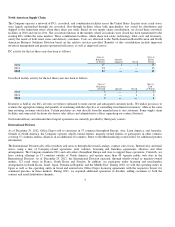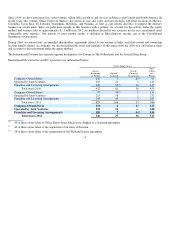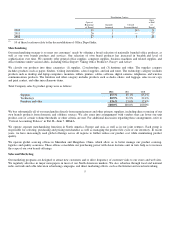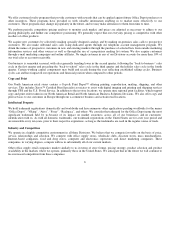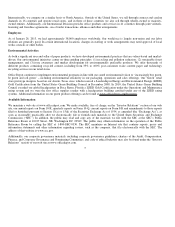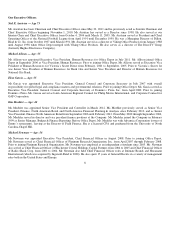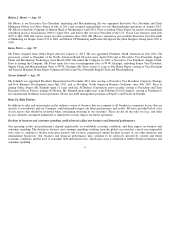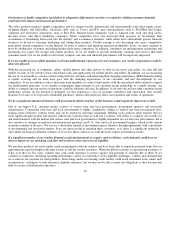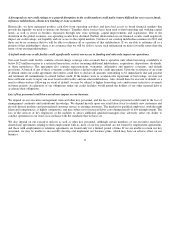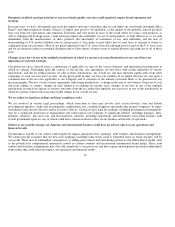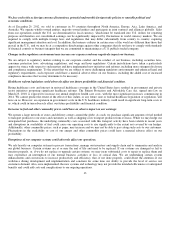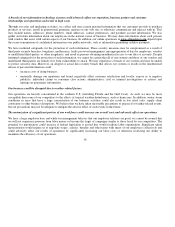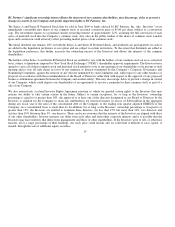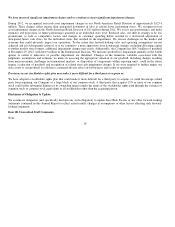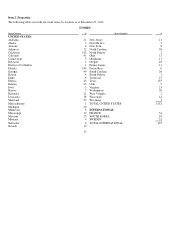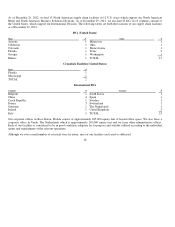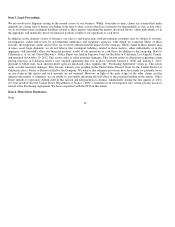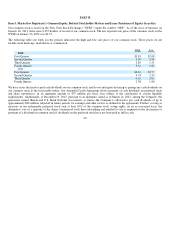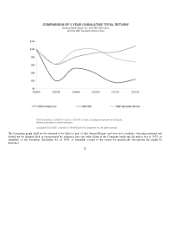Office Depot 2012 Annual Report Download - page 15
Download and view the complete annual report
Please find page 15 of the 2012 Office Depot annual report below. You can navigate through the pages in the report by either clicking on the pages listed below, or by using the keyword search tool below to find specific information within the annual report.
We face such risks as foreign currency fluctuations, potential unfavorable foreign trade policies or unstable political and
economic conditions.
As of December 29, 2012, we sold to customers in 59 countries throughout North America, Europe, Asia, Latin America, and
Australia. We operate wholly-owned entities, majority-owned entities and participate in joint ventures and alliances globally. Sales
from our operations outside the U.S. are denominated in local currency, which must be translated into U.S. dollars for reporting
purposes and therefore our consolidated earnings can be significantly impacted by fluctuations in world currency markets. We are
required to comply with multiple foreign laws and regulations that may differ substantially from country to country, requiring
significant management attention and cost. In addition, the business cultures in certain areas of the world are different than those that
prevail in the U.S., and we may be at a competitive disadvantage against other companies that do not have to comply with standards
of financial controls or business integrity that we are committed to maintaining as a U.S. publicly traded company.
Changes in the regulatory environment may increase our expenses and may negatively impact our business.
We are subject to regulatory matters relating to our corporate conduct and the conduct of our business, including securities laws,
consumer protection laws, advertising regulations, and wage and hour regulations. Certain jurisdictions have taken a particularly
aggressive stance with respect to such matters and have implemented new initiatives and reforms, including more stringent disclosure
and compliance requirements. To the extent that we are subject to more challenging regulatory environments and enhanced legal and
regulatory requirements, such exposure could have a material adverse effect on our business, including the added cost of increased
compliance measures that we may determine to be necessary.
H
ealthcare reform legislation could adversely affect our future profitability and financial condition.
Rising healthcare costs and interest in universal healthcare coverage in the United States have resulted in government and private
sector initiatives proposing significant healthcare reforms. The Patient Protection and Affordable Care Act, signed into law on
March 23, 2010, is expected to increase our annual employee health care costs, with the most significant increases commencing in
2014. We cannot predict the extent of the effect of this statute, or any future state or federal healthcare legislation or regulation, will
have on us. However, an expansion in government’s role in the U.S. healthcare industry could result in significant long-term costs to
us, which could in turn adversely affect our future profitability and financial condition.
I
ncreases in fuel and other commodity prices could have an adverse impact on our earnings.
We operate a large network of stores and delivery centers around the globe. As such, we purchase significant amounts of fuel needed
to transport products to our stores and customers as well as shipping costs to import products from overseas. While we may hedge ou
r
anticipated fuel purchases, the underlying commodity costs associated with this transport activity have been volatile in recent years
and disruptions in availability of fuel could cause our operating costs to rise significantly to the extent not covered by our hedges.
Additionally, other commodity prices, such as paper, may increase and we may not be able to pass along such costs to our customers.
Fluctuations in the availability or cost of our energy and other commodity prices could have a material adverse effect on ou
r
profitability.
D
isruptions of our computer systems could adversely affect our operations.
We rely heavily on computer systems to process transactions, manage our inventory and supply-chain and to summarize and analyze
our global business. Certain systems are at or near the end of life and need to be replaced. If our systems are damaged or fail to
function properly, or, if we do not replace or upgrade certain systems, we may incur substantial costs to repair or replace them and
may experience an interruption of our normal business activities or loss of critical data. We are undertaking certain syste
m
enhancements and conversions to increase productivity and efficiency, that, if not done properly, could divert the attention of ou
r
workforce during development and implementation and constrain for some time our ability to provide the level of service ou
r
customers demand. Also, once implemented, the new systems and technology may not provide the intended efficiencies or anticipated
benefits and could add costs and complications to our ongoing operations.
13


